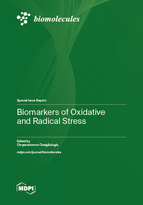Biomarkers of Oxidative and Radical Stress
A special issue of Biomolecules (ISSN 2218-273X). This special issue belongs to the section "Molecular Biomarkers".
Deadline for manuscript submissions: closed (30 June 2023) | Viewed by 24737
Special Issue Editor
2. Center for Advanced Technology, Adam Mickiewicz University, Poznan, Poland
Interests: free radical chemistry; biomimetic chemistry; molecular mechanism; oxidative DNA damage; lipid modification; fatty acid-based lipidomics; biomarkers of radical stress
Special Issues, Collections and Topics in MDPI journals
Special Issue Information
Dear Colleagues,
Reactive oxygen, nitrogen, and sulfur species, including free radicals, are generated in the biological environment as a result of normal intracellular metabolism and function as physiological signaling species that participate in the modulation of apoptosis, stress responses, and proliferation. Some of these reactive species can damage organs, tissues, and cells by oxidizing DNA, proteins, and lipids, thereby resulting in diseases. The enormous importance of oxidative and free-radical chemistry for a variety of biological events, including ageing and inflammation, has motivated studies to understand the related mechanistic steps at the molecular level with the development of related biomarkers.
The identification of modified biomolecules has a diagnostic value for the evaluation of in vivo damage. Therefore, the development of biomarkers through biomolecule modification and characterization by analytical protocols, followed by biomarker validation and extension to clinical research, have important applications in medicine and therapeutical approaches.
This Special Issue covers various aspects of biomarker research: from biomarker identification, including chemical reactivity and analytical procedures, to biomarker validation and pre-clinical applications. Examples include DNA oxidation products, peptide and protein modifications, lipid peroxidation and isomerization, and defense and repair strategies. Research articles and reviews related to these topics are welcome.
Prof. Dr. Chryssostomos Chatgilialoglu
Guest Editor
Manuscript Submission Information
Manuscripts should be submitted online at www.mdpi.com by registering and logging in to this website. Once you are registered, click here to go to the submission form. Manuscripts can be submitted until the deadline. All submissions that pass pre-check are peer-reviewed. Accepted papers will be published continuously in the journal (as soon as accepted) and will be listed together on the special issue website. Research articles, review articles as well as short communications are invited. For planned papers, a title and short abstract (about 100 words) can be sent to the Editorial Office for announcement on this website.
Submitted manuscripts should not have been published previously, nor be under consideration for publication elsewhere (except conference proceedings papers). All manuscripts are thoroughly refereed through a single-blind peer-review process. A guide for authors and other relevant information for submission of manuscripts is available on the Instructions for Authors page. Biomolecules is an international peer-reviewed open access monthly journal published by MDPI.
Please visit the Instructions for Authors page before submitting a manuscript. The Article Processing Charge (APC) for publication in this open access journal is 2700 CHF (Swiss Francs). Submitted papers should be well formatted and use good English. Authors may use MDPI's English editing service prior to publication or during author revisions.
Keywords
- reactive oxygen, nitrogen and sulfur species
- biomarkers discovery
- biological damages
- DNA damage and repair
- protein modification
- membrane lipid modification and signaling
- lipid peroxidation
- antioxidant and redox strategies







